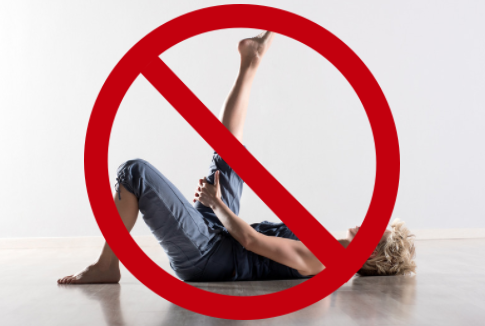A recent Facebook post of ours gathered a lot of attention. The article “Stop Stretching Your Hamstrings.” was posted on March 23rd on the [Core] Chiropractic Facebook page detailing the dangers of stretching your hamstrings and why you should stop. I want to expand upon that article to help continue the conversation and educate the public as to why stretching the hamstrings is harmful for most people.
The general consensus for years has been that when the hamstrings are tight they should be stretched. It makes sense right? The hamstrings are tight, stretching loosens muscles, so stretch them. The vast majority of people stretch with the false hopes of eliminating muscle soreness due to exercise, to improve athletic performance or to prevent injuries. Sadly the science does NOT tell us that one can achieve any of these results, rather, the exact opposite is true.
Stretching a muscle that is already sore from exercise, causes additional trauma to the muscle, thereby slowing the healing process. The stretch pulls apart the fiber connections and re-traumatizes the muscle prolonging recovery. Stretching muscles prior to activity “loosens” them up, also known as decreasing muscle tone. When muscle tone decreases, they are less able to generate force so performance decreases. If that isn’t bad enough, loosened muscles can also no longer keep the joint(s) they interact with as tight (safe from moving improperly), thereby increasing injury opportunity. Take for example a jumping motion: here the hamstring is used to provide a powerful contraction to move the body vertically. At the same time, the hamstring provides stability of the knee posteriorly and laterally. Stretching the hamstrings prior to this activity will decrease the jump and destabilize the knee, so don’t stretch the hamstrings if you want to jump higher and land safely.
So what DOES work when you just have this feeling that the back of your legs are needing a good stretch. What the heck are you supposed to do when your hamstrings feel like overtightened piano wires?
First, change your position. The tightness you are feeling is most likely due to your hamstrings being in an over lengthened (stretched too far) position throughout the day. When you sit around too much the hamstrings are lengthened across the hip joint. Over lengthening any muscle will cause it to want to contract in an effort to return to normal length. This is called the stretch reflex. Your hamstrings feel “tight” when you have been on the couch, in the car, at your work desk, and on the toilet for too long. In effect when you are sitting you are statically stretching the top half of the hamstring. This “tightness” feeling is often referred to as “Neurological Tightness.”
Good posture on left, bad posture on right
What happens in the case of neurological tightness is that because the muscles are lengthened they receive additional neural input which is thought to be a protective response. Essentially, the body is trying to prevent the muscle from being stretched too far, so you experience the sense that the muscle is tight.The best way I can explain this is by thinking of a rubber band. Stretch it as far as you can and the band itself becomes taut. This is exactly what happens to certain muscles in our body particularly with sitting (hamstrings, trapezius, cervical erector spinae, glutes, and rhomboids).
Long periods of sitting are to blame
For simplicity, let’s think about the pelvis being pulled by two strings, one attached to the posterior side of the pelvis and one to the anterior. The anterior side (your front) becomes short, because of excessive periods of sitting, the posterior side (your backside) becomes under stretch. The pelvis becomes tilted forward and the hamstrings become the victim rather than the cause.
So what does this mean to your average office worker? Quite simply, when you sit down in your desk chair, you’re effectively resting your body in a way that it’s all folded up. Picture yourself sitting down in a chair, and then mentally remove the chair. Your knees are halfway to your chest – causing your hips to become tight – and your hamstrings are constantly sitting in a state of being half-stretched all the time.
In this situation, trying to stretch your hamstrings isn’t going to help the problem. Instead, it will simply further lengthen the tissue. You may experience some relief from stretching (similar to when you stretch your lumbar spine), but you aren’t reaching the actual problem and why you feel tight. The relief will only be temporary. Once it passes, you will feel like you need to stretch the hamstrings again, and again.
To get to the root of the problem, you need to be assessed by a movement specialist. The problem could be due to a number of different factors, but the most common is a mechanical tightness of the hip flexors. If your hip flexors are tight, the pelvis can become tilted forward. Because our hamstrings are attached to the back of the pelvis, this tilting will cause the hamstrings to be maintained in a lengthened position.
This means that instead of stretching the hamstrings, you should actually be working on strengthening them so they can counteract the anterior pelvic tilt position, while also working to mobilize the anterior hip.
How to Fix Hamstring Tightness
1. Dumbbell split squats
Pick up a relatively light dumbbell and take a large step forward, as if you were to do a lunge. Then, supporting the weight under your chin, lower yourself down with control, making sure to keep yourself stable and aligned, with your eyes pointing forward.
The split squat is an exercise that should be used in a structural balance phase as it improves ankle mobility and lengthens the hip flexors. Increasing length through your hip flexors will reduce an anterior tilt and decrease the tension placed on the hamstrings. Check out this video for details https://www.youtube.com/watch?v=RiFh2iPzuPo
2. The Lunge Stretch
Place one knee down on the ground and the other foot out in front. The foot should be in front of the forward knee. Lunge through the hip, keeping your chest back during the stretch. The lunge stretch is a great exercise to perform after you have been sitting for longer than 30 minutes or before any workout. This stretch is detailed in our low back pain exercise video: https://www.youtube.com/watch?v=f8XoIoiMmA4
3. Foam Roll the Hamstrings
Foam rolling the hamstrings can be a great alternative to stretching the hamstrings. Foam rolling can improve blood flow to the muscle after prolonged sitting and reduce lactic acid build up after exercise. Try this video for a good tutorial: https://www.youtube.com/watch?v=7fEM1w_BuJk
** All Foam Rollers 10% off thru April 14th! **
4. Kettlebell Swings
The kettlebell swing can be a great tool for strengthening the posterior chain including the hamstrings. This exercise is very functional as it grooves the hip hinge motion pattern used during walking, sit to stand, climbing stairs, and other similar movements. Here is a great video describing the kettlebell swing, https://www.youtube.com/watch?v=GYHbu2LRqD0&t=38s
5. Foundation Training
Foundation training is an exercise program designed to strengthen and coordinate the muscles of the posterior chain. This chain includes the calves, hamstrings, glutes, and spinal erector muscles. Foundation training is an effective tool for improving posture, athletic performance, and decreasing back pain.
[Core] Chiropractic hopes to bring a special Foundation Training workshop to Roanoke in the Summer of 2017.
Keep an eye out for more details soon to be announced!
Until then watch this Foundation Training video and start rehabbing your posterior chain!
If you have questions on this topic feel free to post them on our Facebook page or ask us the next time you are in our Roanoke, Virginia chiropractic office!

Daryl C. Rich, D.C., C.S.C.S.






